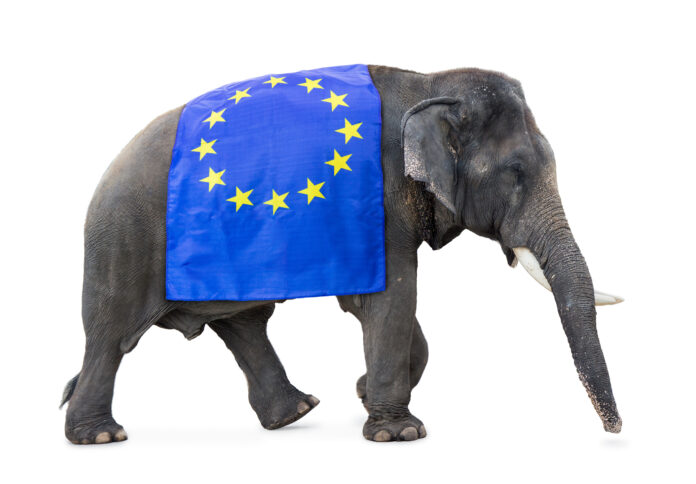Report from the European telco lobby group concludes financial health of the sector is far from improving
ETNO has renewed calls on Big Tech to help pay for the roll-out of 5G and broadband after releasing its latest State of Digital Communications 2024 report, based on research by Analysys Mason. The latest data showed Europe trailing the US and Asia in several technology areas, cloud computing, investments and revenues. The comments come as the European Commission readies a proposal on digital networks and infrastructure on 21 February.
The EU telecoms industry’s hopes of getting Google, Amazon, Netflix, Meta and Microsoft opens to help pay for the rollout of 5G and broadband were dashed last year after the Commission decided not to propose legislation to this effect but to leave it to the next team in 2025.
The report found that telecoms investment reached a record €59.1bn, while six out of 10 Europeans had access to FTTH by the end of last year. However, only 10 out of 114 networks in Europe were 5G standalone (5G SA) last year and the continent was lagging both Asia and North American on edge cloud offers.
Lead or lose
Describing the current situation as “lead or lose”, ETNO’s report found that significant additional investment in 5G roll-outs is still needed. In 2023, 5G in Europe reached 80% of the population, up from 73% the previous year. However, Europe still trailed all its global peers: South Korea (98% 5G coverage), the US (98%), Japan (94%), and China (89%).
The European median mobile downlink speed of 64.1Mbps was lower than that in the US (97.1Mbps), in South Korea (121.1Mbps) and in China (171.6Mbps). Europe also has lower mobile usage: in 2022, Europeans used an average of 14.2GB/month, compared to 17.5GB/month in South Korea, 16.2GB/month in Japan and 15.6GB/month in the US.
When it comes to fixed networks, Europe’s gigabit-capable coverage reached 79.5% in 2023, as opposed to 97% in South Korea, 89.6% in the USA and 81.4% in Japan. On the flip side, Europe’s FTTH coverage of the population (excluding FTTB) reached 63.4% in 2023, up from 55.6% the previous year. However, also this year, Analysys Mason confirms that at the end of the decade, around 40 million people in the EU will still have no access to a fixed gigabit connection.
In 2023 Europe counted 4 commercialised edge cloud offers, all from ETNO members. Despite this, Europe trailed both the Asia-Pacific region, which counted 17 offers, and North America (9). Similarly, in the same period, we counted 59 operative edge nodes in Europe, as opposed to 159 in North America.
Weak fundamentals
ETNO said the delays in deployment, which affect users, are mirrored in both suboptimal investment per capita and the overall weak financial health of the sector, which are cause of concern in terms of competitiveness. In 2022, telecom capex per capita in Europe stood at €109.1, lower than in South Korea (€113.5) and far lower than in the US (€240.3). In absolute terms, however, European telecoms investment reached €59.1bn in 2022, up from €56.3bn the previous year, with 60 to 70 % being dedicated to mobile and fixed network rollout.
The revenues of the sector, measured with average revenue per user (ARPU), remains the weakest of all global peers: In 2022, mobile ARPU was €15 in Europe, as opposed to €42.5 in the US, €26.5 in South Korea, and €25.9 in Japan. The same is true for fixed broadband ARPU, which was €22.8 in Europe, as opposed to €58.6 in the USA and €24.4 in Japan. Only South Korea was lower (€13.1).
Absorbed inflation
The report found that European operators have in effect absorbed inflation on behalf of their customers, meaning that revenue decreased in real terms. EU telecoms retail revenues rose in 2021 and 2022 by only 0.7% and 2.1% respectively, growth figures that are more than offset by inflation, which stood at 2.9% in 2021 and 9.2% in 2022.
This is mirrored in the fact that the return on capital employed (ROCE) of ETNO members has almost halved in the recent past: in 2017 ROCE was 9.1%, while in 2022 it was 5.8%, signalling that it is increasingly difficult for European telcos to generate adequate returns on their investment. This happens against a scenario in which European retail markets remain uniquely fragmented and a real European telecom single market remains unaccomplished.
The report found that in 2023 Europe counted 45 large mobile operating groups with more than 500.000 customers, as opposed to 8 in the USA, 4 in both China and Japan, and 3 in South Korea.
Elephant in the room
The study reminded EU regulators of the Rights and Principles Declaration from 2022 which says that all market actors benefiting from the digital economy should make a “fair and proportionate contribution” to digital network investment. “The debate will shape the longer-term strength of the European telecoms sector, as well as its overall investment capacity,” the report said.
“Users are expecting new networks and Europe’s competitiveness relies on innovative connectivity. This is why we must take urgent policy action to help strengthen the European telecom sector,” said ETNO director general Lise Fuhr. “The status quo – both in terms of investment and of policy – will not deliver the levels of innovation that are so desperately needed to sustain growth and deliver on the Open Strategic Autonomy.”



